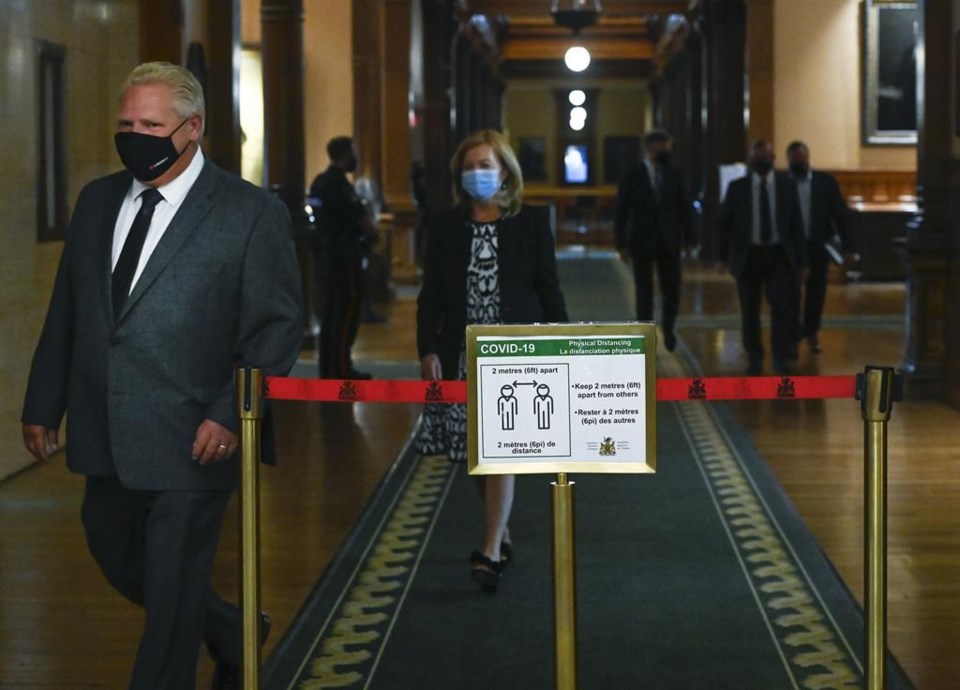Ontario will increase COVID-19 testing in its long-term care homes in an effort to pinpoint how the virus is getting into the facilities, Premier Doug Ford said Monday as more new cases and deaths were reported in the sector.
Better surveillance testing for residents, staff and visitors – which is conducted even if a person does not have symptoms of the virus – and faster turnaround times for results are needed to get at the "root cause" of rising infection rates, Ford said.
"We need to lock it down," he told reporters. "Not just testing people, but getting the results back and having a standard test that we can get it back in 24 hours, 48 hours."
Ford's comments came after the province reported 20 deaths among nursing home residents on Sunday. Another four resident deaths were reported Monday.
According to the province, 107 of Ontario's 626 long-term care homes are currently experiencing an outbreak, and 716 residents currently have COVID-19.
Data released by the government last week showed that mortality rates in long-term care homes have been on the rise during the second wave of the pandemic.
Overall, 2,145 residents of Ontario's long-term care homes have died since the start of the pandemic.
Ford suggested staff and visitors may unwittingly be bringing the virus into long-term care homes. Rapid COVID-19 tests may help with that when they arrive in Ontario, he added.
"Go to root cause ... why do we have an infection?" he said. "It's not coming in from the clouds. It's not coming in from the patients. It's coming in from outside."
Nathan Stall, a clinical epidemiology and health-care researcher at the University of Toronto, said bolstered testing will not be enough to halt the spread of COVID-19 in long-term care.
"Testing is an important tool to try and help prevent and mitigate outbreak," he said. "But it's a downstream solution. If (the premier) wants to talk about the root cause, the root cause is about suppressing transmission of COVID-19 in the community."
Stall said the government must impose strict measures to eliminate community spread to a point where public health officials can once again effectively conduct contact tracing.
"With the levels of cases we have now, it would require a substantial shutdown ... instead of trying to manage what I would call now a controlled burn, which is rapidly spiraling out of control."
Ontario reported 1,487 new cases of COVID-19 on Monday, and 10 new deaths due to the virus. The government said 508 of those cases were in Toronto, 392 in Peel Region and 170 in York Region.
Long-term Care Minister Merrilee Fullerton said Monday that the province is revamping criteria that would reduce access to homes in COVID-19 hot spots.
Public health units can also impose their own measures if they deem them necessary, she added, without specifying what those might be.
"We learned this in the first wave, that actually the public health units ... can actually respond fast," she said. "(The province's) measures take somewhat longer. And I think time is of the essence, I say we need to respond in COVID time and ... medical officers of health can do that."
NDP Leader Andrea Horwath accused Fullerton of ducking her responsibility as minister.
"It looks like she's preparing to scapegoat public health departments as a result of the government's failures," Horwath said. "This government did nothing all summer long. They didn't hire more PSWs, they didn't bring in infection control specialists for each and every home."
Liberal House Leader John Fraser said the Fullerton was minimizing her role in the state of long-term care homes.
"The minister should just take responsibility and own it," he said.
Fullerton's office later clarified her remarks, saying local health units can layer on additional visitor restrictions to the government's current COVID-19 response system.
"We will continue to work together with all partners to protect our most vulnerable, ” spokeswoman Krystle Caputo said.
Meanwhile, the province introduced a new strategy Monday to prevent and control COVID-19 outbreaks on farms. It said the plan will bolster inspections, infection-control measures, and virus testing.
The province said it and the federal government are committing $26 million to support on-farm health and safety. It will contribute an additional $25 million over three years to minimize the risk of agri-food workplace exposure.
The move comes after hundreds of migrant workers in Southwestern Ontario contracted COVID-19, shining a light on their working and living conditions during the pandemic.
This report by The Canadian Press was first published Nov. 16, 2020.
The Canadian Press



